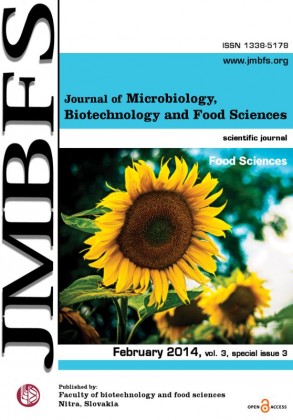CADMIUM AND NICKEL CONTENT IN FROZEN SPINACH FROM SLOVAKIA SALES NETWORK
Keywords:
spinach, heavy metals, cadmium, nickel, pollutionAbstract
In the present work, we focused on monitoring the content of hazardous elements in retail packs Spinach (Spinacia oleracea, L.). Among the most hazardous substances that can get into the spinach are nitrates, pesticide residues. The heavy metals as cadmium, mercury, cobalt, nickel, lead and copper. Into productive parts of plants may get land through the atmosphere or contaminated water. Spinach is among reigns supreme wheatgrass. It is a rich source of minerals, vitamins and folic acid. For this article we have chosen to risk elements cadmium and nickel, which we compared with the maximum level defined by the Codex Alimentarius Commission of the Slovak Republic and the values that are set out in Commission Regulation EU No. 420/2011 and no. No 1881/2006 setting maximum levels for contaminants in foods. The results obtained suggest that in either case there was no exceeded of monitored contaminants. The average levels observed risk elements were in the following intervals: Cd 0:03 to 0:10 mg.kg-1, Ni 0697-1218 mg.kg-1. The results will show that in the case of cadmium, we had exceeded the limit value in six samples and nickel was not exceeding the limit value.Downloads
Download data is not yet available.
Downloads
Published
2014-02-01
How to Cite
StanoviÄ, R., Július, ÃÂrvay, ĽuboÅ¡, H., Michal, K., & Tomáš, T. (2014). CADMIUM AND NICKEL CONTENT IN FROZEN SPINACH FROM SLOVAKIA SALES NETWORK. Journal of Microbiology, Biotechnology and Food Sciences, 3(special issue 3 (Food Sciences), 289–290. Retrieved from https://office2.jmbfs.org/index.php/JMBFS/article/view/7593
Issue
Section
Food Sciences
License
Copyright (c) 2014 Radovan StanoviÄ, ÃÂrvay Július, Harangozo ĽuboÅ¡, Kujovský Michal, Tóth Tomáš

This work is licensed under a Creative Commons Attribution 4.0 International License.
All papers published in the Journal of Microbiology, Biotechnology and Food Sciences are published under a CC-BY licence (CC-BY 4.0). Published materials can be shared (copy and redistribute the material in any medium or format) and adapted (remix, transform, and build upon the material for any purpose, even commercially) with specifying the author(s).

